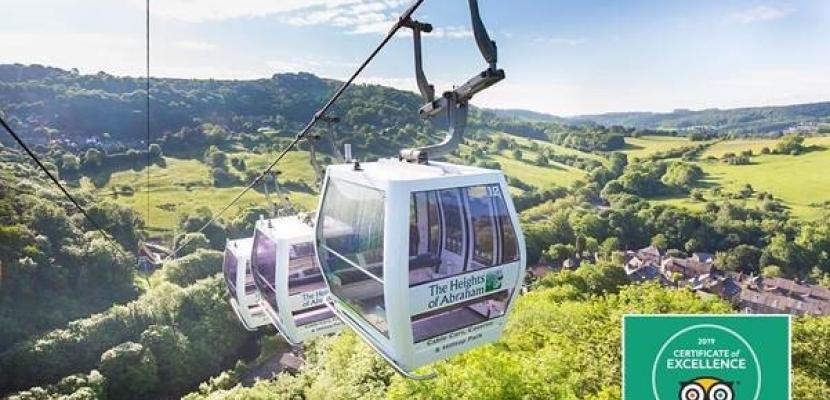Image

Heights of Abraham Cable Car as a low-carbon tourism mobility system
Published on 23 July 2020

United Kingdom
Derbyshire and Nottinghamshire
This is the good practice's implementation level. It can be national, regional or local.
About this good practice
The Heights of Abraham Cable Car is a gondola lift (teleferic) in the English county of Derbyshire. It is 568 m long and links the spa town of Matlock Bath with the Heights of Abraham, a tourist attraction 169 m above. The line opened in Spring of 1984. The cable cars were upgraded in 2004, making them larger and more accessible, to 12 six-seater cabins, which operate in four trains of three cabins each.
The cable gars offer low-carbon, electric-powered, mobility and access for visitors to the Heights of Abraham tourism attractions: cavern and mine tours, panorama of the river Derwent valley. The Heights of Abraham are listed in the register of historic parks and gardens of special historic interest in England.
Each of the 12 cars are permanently attached to the cable by huge metal bolts. The cable is one long loop and is kept in tension on giant rollers. The cable itself is 1136 metres long (2-way).
The lower station of the cable car is located on the opposite bank of the River Derwent to the Heights of Abraham and the town of Matlock Bath, with the cabins crossing the river at the lower end of their journey. A footbridge provides access from the town to the lower station, which is also situated a short walk away from Matlock Bath railway station.
The cable cars move by a 360 horse power, very sturdy, electric motor located at the Base Station.
The cable cars slow down to let people on at the bottom. They stop completely to let people with pushchairs and wheel
The cable gars offer low-carbon, electric-powered, mobility and access for visitors to the Heights of Abraham tourism attractions: cavern and mine tours, panorama of the river Derwent valley. The Heights of Abraham are listed in the register of historic parks and gardens of special historic interest in England.
Each of the 12 cars are permanently attached to the cable by huge metal bolts. The cable is one long loop and is kept in tension on giant rollers. The cable itself is 1136 metres long (2-way).
The lower station of the cable car is located on the opposite bank of the River Derwent to the Heights of Abraham and the town of Matlock Bath, with the cabins crossing the river at the lower end of their journey. A footbridge provides access from the town to the lower station, which is also situated a short walk away from Matlock Bath railway station.
The cable cars move by a 360 horse power, very sturdy, electric motor located at the Base Station.
The cable cars slow down to let people on at the bottom. They stop completely to let people with pushchairs and wheel
Resources needed
The project cost around 1 million Pounds Sterling in 1983, giving a cost per km at approx. 2 million €/km.
As cable cars allow a high level of automated operation, their costs are significantly lower than is the case for modes of transport operated by a person. The energy costs are likewise low.
As cable cars allow a high level of automated operation, their costs are significantly lower than is the case for modes of transport operated by a person. The energy costs are likewise low.
Evidence of success
Installation of UK’s first Alpine-style cable car system commenced in Sep. 1983 and opened to the public in April 1984. Tourist attractions include exciting underground tours of two spectacular show caverns. Above ground there are play areas, picnic spots, the Fossil Factory, Heath & Heaven and Who-Why-What Exhibitions, shops, cafe and summit bar, all with stunning views across the surrounding Peak District.
The Heights of Abraham has featured on numerous television programmes.
The Heights of Abraham has featured on numerous television programmes.
Potential for learning or transfer
As the mass ratios and wind resistances of the respective directions of travel on cable cars offset one another, only the energy to overcome the system friction must be supplied to the systems. Cable cars therefore represent the most energy efficient motorised means of transport available and are therefore a relatively cheap means of transport.
Cable cars offer the possibility of private financing and private commercial system operation. Cable cars themselves can become a property development instrument as a result of their attraction value.
Due to the above advantages, the successful experience of teleferic/ropeways may form the basis for transfer to destinations where access to tourist attraction(s) by low-carbon transport is required. The capital cost are reasonable and there can be additional revenues from ‘Park & Ride’ operation, as well environmental benefits. The aesthetics of cable cars give a destination a very good image, with smart & sustainable, low-carbon tourism mob
Cable cars offer the possibility of private financing and private commercial system operation. Cable cars themselves can become a property development instrument as a result of their attraction value.
Due to the above advantages, the successful experience of teleferic/ropeways may form the basis for transfer to destinations where access to tourist attraction(s) by low-carbon transport is required. The capital cost are reasonable and there can be additional revenues from ‘Park & Ride’ operation, as well environmental benefits. The aesthetics of cable cars give a destination a very good image, with smart & sustainable, low-carbon tourism mob
Further information
Website
Good practice owner
You can contact the good practice owner below for more detailed information.
Organisation
Derbyshire County Council

United Kingdom
Derbyshire and Nottinghamshire
Contact
Senior Lecturer